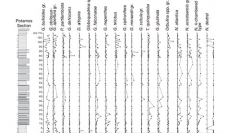

 Geodiversitas
29 (3) - Pages 379-399
Geodiversitas
29 (3) - Pages 379-399The present study describes the early late Miocene paleoenvironmental evolution and the main paleoclimatic trends of Gavdos Island (eastern Mediterranean) reconstructed using planktonic foraminifera. The three stratigraphic sections studied in this area are characterized by whitish to greyish marls and sands (Potamos and Ag. Giannis sections) and by grey-bluish marls and reefal limestones (Bo Section). Based on the distributional pattern of neogloboquadrinids in the three sections, we attribute a lower Tortonian age to studied sediments, corresponding to the interval ranging between 11.21 to 10.01 Ma. Four distinct assemblages of planktonic foraminifera were identified by Q-mode cluster analysis. The succession of assemblages allows dividing each section into four paleoceanographic stages: 1) a warm-oligotrophic stage characterized by the prevalence of Globigerinoides obliquus-Globoturborotalita apertura; 2) a cool-eutrophic stage characterized by Neogloboquadrina acostaensis; 3) upwelling conditions dominated by Globigerina bulloides; and 4) a relatively warm with seasonal high productivity stage characterized by the N. acostaensis and Globigerinoides trilobus. On the basis of planktonic foraminifera paleoclimatic indices, paleoclimatic curves were constructed for each section. Our data suggest that, although adjacent, the areas where the three sections are located underwent different paleoclimatic and paleoenvironmental evolution during early late Miocene: Bo shelf is characterized by warmer, nearly oligotrophic conditions compared to cooler and eutrophic conditions on the adjacent Potamos and Ag. Giannis shelves. This difference is probably related to the presence of an island between Bo shelf and the open sea which acted as a local oceanographic and biogeographic barrier.
Planktonic Foraminifera, paleoclimate, paleobiogeography, early late Miocene, Gavdos Island, Greece